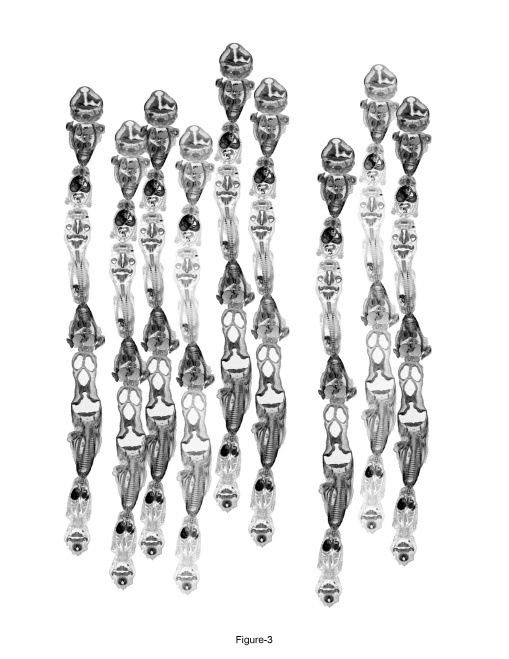by BRAD SMITH
The social, political, and moral status granted to life forms is argued by individuals and groups with vested interests in the life form, it is brokered through power structures, and it is susceptible to the choices of language and visual depictions used to name and represent the life form.
What status should be given to mutated, altered, transgenic, artificial, hybridized, or extreme biological forms? What status is implied when they are considered property, tissue, life, cure, pandemic, organism, member of society, or alien?
I will address processes by which society ascribes status to living entities by using examples from my own research in magnetic resonance imaging of embryos. I will also present my own depictions of ambiguous life using photo-micrographs, MRI’s, ultrasounds, and images of pseudo-transgenic manipulated human embryos. I will discuss how these depictions were permitted and facilitated by complex social structures and how these endorsed depictions then constrained and altered continued access to the same embryos.
Of particular interest to me is the manner in which visually depicting an embryo politicizes it and makes it “known.” Its meaning (and status) can be variously conferred and implied by direct sight, drawings, ultrasounds, paintings, photographs, sculptures, virtual models, in-utero video, or MRI’s. Each depiction results in a unique interpretation. How do various forms of depictions alter the status of life forms that are novel or conentious? Consider the inferred status of the human embryos depicted below.



EMBRYOS AS EXAMPLES OF CONTENTIOUS LIFE FORMS
The range of issues surrounding these questions is mirrored in the contemporary debate about assigning a status to the human embryo vis-a-vis cloning and stem cell research. The following questions relevant to human embryos suggest what is also relevant to new, ambiguous, and extreme forms of life:
- What should be done with excess in-vitro fertilized frozen embryos?
- Should embryos be used in research to seek relief from disease and suffering?
- Should embryos be created for the purpose of research?
- At what stage of biological complexity or human development is research on human biological material justified or not justified?
- What role should various institutions play in deciding these matters?
The questions above suggest what might become relevant to the creation and use of ambiguous and extreme forms of life:
- What status should be given to any form of life?
- Is the status inherent or granted?
- What biological attributes should be used to ascribe status?
- What non-biological attributes might be used?
- How does status change as life develops, alters, matures, mutates, converges, or hybridizes?
- What events can or should serve as landmarks for attributing changing status?
Nomenclature also politicizes the life forms we describe. In the case of the human embryo, its status is implied by one of the various names it might be given. Consider how the standing of this entity changes by the title it is given: embryo, un-born baby, zygote, child, conceptus, Emily, specimen, son, organism, patient, tissue, person, life form. The language used to describe extreme life forms will project attitudes and assumptions onto those forms just as these names have done to the life entities involved in stem cell research and cloning.
Individuals and society attempt to define behaviors that are appropriate toward developing life, developed life, or in the case of this symposium, ambiguous or extreme life. Informed by the example of human embryos, possible behaviors might include:
- Inaction
- Bringing the life into existence
- Nurturing the life within its own system
- Intervening to assist development
- Suspending development
- Terminating development
- Using for self interest
- Using for the interest of others with no harm to this life
- Using for the interest of others with possible or certain harm or termination of this life
- Ambiguous or mixed actions
Deciding permissible behaviors toward varying life forms is a contentious social process with profound and emotion-laden consequences.
Who are the stakeholders in deciding what behaviors are appropriate? Who will be affected, who is concerned, or who has an interest? Human embryo debates suggest who the stakeholders might be and how their interests might compete:
· Individuals with proximate, direct, biological concerns (the sick, the frozen morula, the stem cell, the infertile, the extreme life form)
· Individuals with personal, indirect, non-biological interests (family of the sick, family of the unborn, researcher, politician, business owner, inventor, ethicist, artist/designer)
· Classes of people with group interests (governments, citizens, policy makers, industries, religions, advocates of various values and causes)
Ascribing status to ambiguous or extreme life forms is divisive because the interests of various stakeholders often conflict or compete. Some stakeholders have direct, biological concerns and others have indirect, political, economic, or social concerns. Some individuals will belong to multiple groups with opposing agendas. Who are the stakeholders that have an interest in deciding what behaviors are appropriate toward ambiguous or extreme life forms? How will the power structures between these groups permit, obstruct, deflect, or facilitate the evolution of these life forms?
SUMMARY
The status ascribed to novel or extreme life forms will be decided by those who have direct and indirect interest in these life forms, it will be responsive to the language used to describe these life forms, and it will be highly sensitive to the images used to portray them. Artists, scientists, designers, creators, politicians, industry, and special interest groups will use these tools of persuasion to affect the values and social status ascribed to the novel life forms currently being envisioned and produced.


